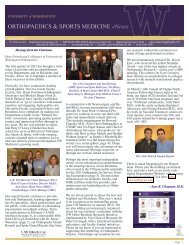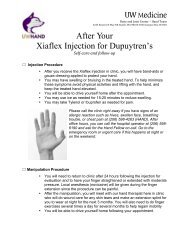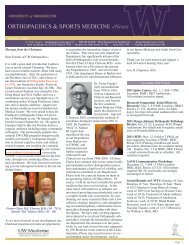2002 - University of Washington Bone and Joint Sources
2002 - University of Washington Bone and Joint Sources
2002 - University of Washington Bone and Joint Sources
Create successful ePaper yourself
Turn your PDF publications into a flip-book with our unique Google optimized e-Paper software.
Ewing’s cell lines; SK-ES cells have<br />
higher expression than SK-N-MC <strong>and</strong><br />
both have higher levels <strong>of</strong> expression<br />
than HeLa cells. Northern blotting was<br />
performed to examine the expression<br />
<strong>of</strong> TASR proteins in different tissues.<br />
TASR mRNAs were found to be<br />
ubiquitously expressed <strong>and</strong> are most<br />
abundant in testis.<br />
Figure 2: TASR expression in mouse tissues. Poly (A) mRNA from mouse tissues blotted with a DNA<br />
probe specific for both TASR 1 <strong>and</strong> 2. Molecular Weight is indicated on the left. Tissue type is above<br />
the corresponding lane. Specific TASR expression is indicated by arrows with MW in parenthesies.<br />
Figure 3: This is an example <strong>of</strong> a peripheral neuroectodermal tumor, a variant <strong>of</strong> Ewing’s Sarcoma.<br />
These remain devastating diseases thus the need for continued basic research.<br />
RESULTS AND DISCUSSION<br />
Sequencing analysis <strong>of</strong> mouse <strong>and</strong><br />
human genomic DNAs revealed that<br />
TASR-1 <strong>and</strong> 2 are in fact encoded by a<br />
single gene in each species <strong>and</strong> are the<br />
result <strong>of</strong> alternative splicing. Even<br />
though TASR-1 <strong>and</strong> TASR-2 share the<br />
same sequence in the 5’ untranslated<br />
region <strong>and</strong> in the region encoding the<br />
N-terminal domain, these two genes<br />
diverge in regions encoding the C-<br />
terminal domain <strong>and</strong> the 3’<br />
untranslated region. Several<br />
polyadenylation sites are observed in<br />
both TASR-1 <strong>and</strong> 2 genomic sequences,<br />
resulting in the generation <strong>of</strong> multiple<br />
mRNA transcripts encoding each TASR<br />
protein. The range <strong>of</strong> expression <strong>of</strong> the<br />
splicing <strong>and</strong> polyadenylation variants<br />
<strong>of</strong> the TASR gene in human tissue may<br />
reflect their essential roles in the proper<br />
control <strong>of</strong> cell growth <strong>and</strong><br />
differentiation.<br />
It also appears that pseudogenes are<br />
present within the human <strong>and</strong> mouse<br />
genomic sequences for both TASR-1<br />
<strong>and</strong> 2. Pseudogenes in essence are<br />
nonfuntional stretches <strong>of</strong><br />
complementary DNA, or “retroposons”,<br />
that have been introduced into the<br />
genome by reverse transcriptions. This<br />
is significant because it demonstrates<br />
that the TASR proteins are<br />
evolutionarily ancient <strong>and</strong> that they are<br />
critical molecules in the normal<br />
physiology <strong>of</strong> mammalian cells. This is<br />
confirmed by the Northern blot results<br />
which showed that the TASR proteins<br />
are ubiquitously expressed.<br />
The expression <strong>of</strong> TASR 1 was<br />
found to be highly expressed in Ewing’s<br />
sarcoma cell lines versus Hela cells. This<br />
may represent a compensatory<br />
response by the Ewing’s cells to the<br />
EWS/Fli-1-mediated disruption <strong>of</strong> the<br />
normal interaction between TASR<br />
proteins <strong>and</strong> EWS. These splicing<br />
proteins appear to play an importaant<br />
role in the development <strong>of</strong> a variety <strong>of</strong><br />
sarcomas. Underst<strong>and</strong>ing the structure<br />
<strong>of</strong> TASR-1 <strong>and</strong> TASR-2 is an important<br />
step towards developing targeted<br />
28 <strong>2002</strong> ORTHOPAEDIC RESEARCH REPORT















